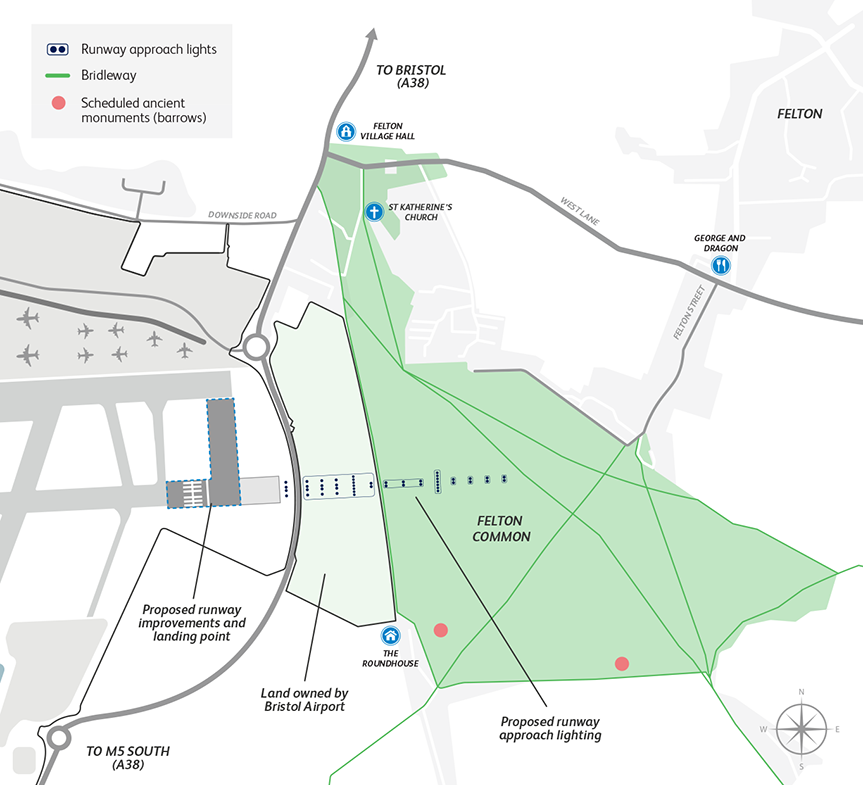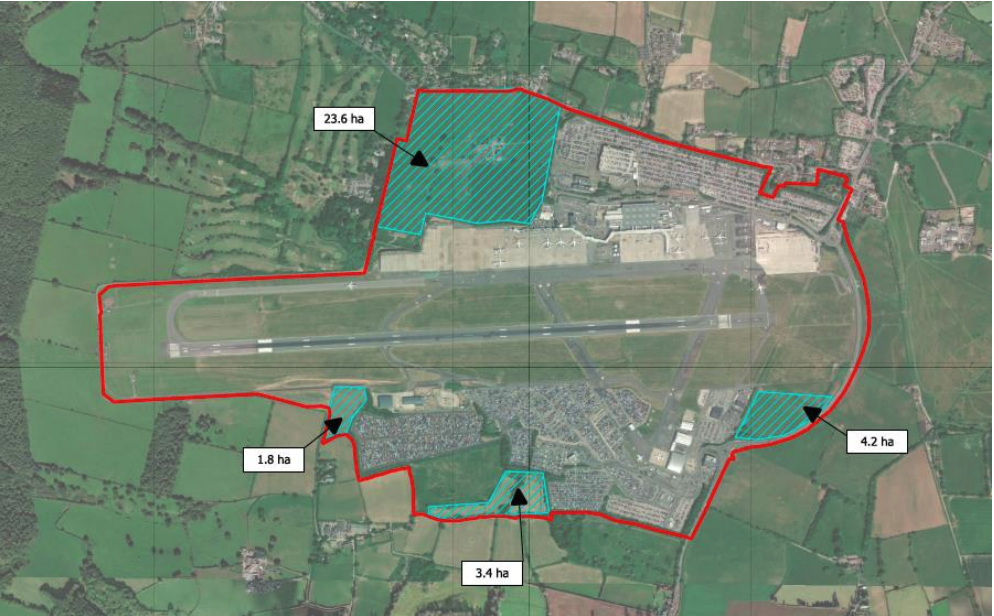Bristol Airport



Overview of the Proposal
- Bristol Airport has published a Master Plan to 2040 which envisages increasing its annual passenger capacity to 15 million (from its current ~10.5 m and planning permission already for ~12 m). (BristolWorld)
- To support this growth and longer-haul routes (to North America/Middle East) the airport is proposing various infrastructure upgrades: for example, moving runway approach lighting and installing additional safety features on the eastern end of the runway. (BristolWorld)
- Crucially, some of the proposed works would require development on land currently designated as Green Belt and/or common/open access land (specifically parts of Felton Common). (Bristol24/7)
What land is involved & what kind of development?
- The Master Plan acknowledges that “the proposed development would require the release of additional land from the Green Belt … to extend the apron, accommodate the fuel farm and aviation-related buildings, and meet demand for additional parking.” (bristolairport.co.uk)
- The works on the approach lighting, as reported recently, would be on “parcels of land on Felton Common (the greenspace next to the Airport)”. (BristolWorld)
- The airport, in its own planning statement, says these highway/airport infrastructure works are located in the Green Belt and they argue that although these may be “inappropriate development” under Green Belt policy, they will make the case for “very special circumstances” to justify them.
Key Planning / Policy Issues
- Green Belt land in England is subject to strong protection: one of its main purposes is to preserve openness and prevent urban sprawl. (Wikipedia)
- The airport’s documents state explicitly: “We accept that our proposals could be considered inappropriate development within the Green Belt and we will be making the case with justification (called ‘very special circumstances’ …)”. (bristolairport.co.uk)
- In planning policy terms, parts of the works may qualify as “local transport infrastructure” (which is one of the limited forms of development that can sometimes be acceptable in Green Belt) if the case is well made and environmental/visual impacts are controlled.
Environmental & Community Concerns
- Local campaigners oppose the expansion on multiple grounds: loss of open space/common land, biodiversity impact, increased noise, traffic, and carbon emissions. For example, the group Bristol Airport Action Network (BAAN) argues the proposal is “absolutely outrageous and unacceptable” as it extends onto Felton Common, a valued green space. (Bristol24/7)
- A recent environmental audit report cast doubt on the claimed economic benefits of the expansion when weighed against climate and ecological harms. (Bristol24/7)
Timeline & Next Steps
- The consultation on the approach lighting / land use changes is scheduled for six weeks from 7 November to 19 December 2025. (BristolWorld)
- A full planning application is expected to be submitted in early 2026 for the infrastructure needed to reach the 15 million passenger goal. (BristolWorld)
- The Master Plan revision (to 2040) and associated planning documents provide the framework, but each infrastructure element (lighting, apron extension, car parking, etc.) may come as separate planning permissions and needs to justify Green Belt release.
What this means for the Green Belt / Local Area
- If approved, parts of the green belt/open access land will be changed in designation and/or used for airport‐related development. This represents a significant change in how that land is used.
- The airport is promising mitigation: e.g., efforts to screen lighting, limit building height in Green Belt land, ensure access is maintained for bridleways, etc. (BristolWorld)
- However, for many locals the key concerns are about longer term precedent (once Green Belt is released for one infrastructure project, what prevents others?), and the cumulative effect of growth in flights, traffic, and environmental pressures.
Why the Airport argues it is necessary
- The airport insists it is critical for regional connectivity, economic growth and job creation; it says the expansion will help serve new destinations, connect to overseas markets and deliver greater choice for travellers in the South West. (BristolWorld)
- It also links the infrastructure upgrades to ensuring safe operations (e.g., installing approach lighting so runway works remain safe in all weather/for larger aircraft). (BristolWorld)
- It emphasizes its commitments on sustainability: e.g., the airport has a Sustainability Strategy targeting a 73% cut in its operational emissions by 2027 and net-zero operations by 2030. (AGN)
My Assessment / Key Issues to Watch
- “Very special circumstances”: Because Green Belt protection is strong, the airport’s case will centre on demonstrating that the benefits (safety, connectivity, economic growth) outweigh the harm to openness and the other Green Belt purposes.
- Mitigation vs impact: While the airport offers mitigation (landscape screening, limiting height, giving replacement land etc), the net effect on biodiversity, common land users and community rights will be under scrutiny.
- Transport and sustainability: Even if the infrastructure is upgraded, community groups argue that growth in flights and traffic may undermine carbon/ net-zero commitments. The airport will need to demonstrate that expansion doesn’t simply mean more cars on local roads, more night flights, etc.
- Local democratic and planning process: The six-week consultation and then the planning application will be key moments. Local objections and representations will matter.
- Precedent: The release of Green Belt land for one development often sets a precedent for further releases; so many local residents see this as a potentially incremental step to larger scale change in the green belt.
- Here’s a detailed case study and commentary breakdown on the Bristol Airport Expansion Proposal, particularly its controversial plan to extend into Green Belt land.
Case Studies
Case Study 1: Bristol Airport’s Master Plan 2040 — Balancing Growth and Sustainability
Background:
Bristol Airport’s Master Plan to 2040 outlines a vision to increase passenger capacity from around 10.5 million to 15 million annually. To accommodate this, the airport proposes extending facilities, such as taxiways, approach lighting, car parking, and operational buildings — some of which overlap with Green Belt and common land, notably parts of Felton Common.Key Actions:
- Extending aircraft aprons and relocating approach lights for safety.
- Adding car parking and service roads.
- Expanding terminal facilities and fuel farm areas.
Outcome & Challenges:
The expansion aims to meet rising regional travel demand and attract more long-haul routes (to North America and the Middle East).
However, it faces significant hurdles:- The Green Belt designation restricts non-essential development.
- Environmental groups and locals argue the move conflicts with the UK’s Net Zero 2050 commitment.
- The airport must prove “very special circumstances” exist to justify building in a protected area.
Comment:
This case highlights the growing friction between economic development and environmental conservation. Bristol Airport’s strategy resembles expansion plans seen at Luton and Stansted, where operators justified growth through safety, connectivity, and economic gain — but only after pledging extensive environmental mitigation.
Case Study 2: Felton Common — Local Resistance and Green Belt Protection
Background:
Felton Common, a public green space near the airport, sits within the Avon Green Belt and is cherished by walkers, cyclists, and local communities. The proposed runway lighting relocation and safety zone expansion would directly impact parts of this land.Community Response:
The Bristol Airport Action Network (BAAN) and local parish councils have voiced opposition. They argue the works would:- Erode the openness of the Green Belt.
- Increase light pollution and noise in rural areas.
- Set a dangerous precedent for future encroachment.
Environmental Impact:
Felton Common is home to diverse flora and fauna. Environmental consultants have warned that new infrastructure could disrupt wildlife habitats and diminish biodiversity.Comment:
This mirrors resistance seen in the Heathrow third runway case, where communities successfully delayed approval due to environmental concerns. It demonstrates how local activism, backed by environmental law, can influence major infrastructure outcomes.
Case Study 3: Economic Justification vs. Ecological Cost
Background:
Bristol Airport claims the expansion could add £2.5 billion to the regional economy and create over 5,000 new jobs.
However, a 2024 independent environmental audit questioned these benefits, suggesting that:- The carbon cost and public transport strain would offset economic gains.
- Increased air traffic could undermine local and national climate targets.
Policy Context:
The airport argues that expansion aligns with the West of England Combined Authority’s (WECA) growth ambitions, but environmental reports say this contradicts local sustainability policies.Comment:
This tension between economic benefit and climate accountability has become central to infrastructure debates across the UK. The Bristol case will likely influence how future airport expansions justify environmental trade-offs.
Expert & Public Commentary
1. Environmental Planners’ Perspective
“The Green Belt isn’t just empty land; it’s a strategic buffer that protects rural identity. Once it’s developed, the damage is irreversible.”
— Dr. Hannah Lewis, Urban Planning Lecturer, University of the West of EnglandLewis notes that while infrastructure upgrades can be argued as essential for regional development, the cumulative impact of multiple Green Belt encroachments weakens national planning integrity.
2. Aviation Industry View
“Airports like Bristol are critical for regional connectivity. Expanding capacity responsibly — with strict sustainability targets — ensures economic resilience.”
— Simon Jenkins, UK Airports AssociationThe industry sees the Bristol proposal as part of a regional balancing act, reducing dependency on Heathrow and supporting the South West’s business ecosystem.
3. Community Voices
“It’s not just about the lights or tarmac — it’s about losing a place that defines our community.”
— Local resident, Felton Common campaignGrassroots groups emphasize that once the land is reclassified and developed, it can’t easily be restored. They call for investment in rail links or green travel incentives instead of more flights.
4. Policy Analyst Comment
“This case may set a precedent for how ‘very special circumstances’ are interpreted in aviation planning.”
— David Morton, UK Green Infrastructure Policy ForumIf approved, the Bristol expansion could redefine what counts as an acceptable Green Belt exception — potentially opening doors for other regional airports to pursue similar arguments.
Summary Analysis
Aspect Pro-Airport Argument Opposition View Economic Growth Boosts jobs, tourism, and investment Economic benefits overstated; climate costs ignored Regional Connectivity Links South West to global markets Alternatives (rail or smaller terminals) underused Green Belt Impact “Very special circumstances” for safety and infrastructure Permanent loss of protected land Environmental Footprint Promises net-zero operations by 2030 Air traffic emissions outside scope of that pledge Community Benefit Improved facilities and accessibility Increased noise, traffic, and urban sprawl
Conclusion
The Bristol Airport Green Belt expansion proposal stands as a test case for the balance between local sustainability goals and national aviation ambitions.
- If approved, it may reshape planning precedent for Green Belt policy interpretation.
- If rejected, it will reaffirm the strength of environmental protection frameworks in the UK’s post-Net Zero planning era.
Either outcome will ripple beyond Bristol — influencing airport, infrastructure, and environmental policymaking across the country.
